For English version click on “BEITRAG LESEN/READ THE POST” and then scroll to bottom
Nachdem wir den Campingplatz bei San Cristobal de las Casas nicht anfahren konnten, machen wir uns auf den Weg Richtung Aqua Azul und Palenque. Unsere Tagesetappe führt uns über die MEX-186 bis Tonina, wo wir auf einen Campingplatz kurz vor den Ruinen einchecken. Die MEX-186 ist gefühlt mit tausenden Topes gespickt, aber ganz so viele sind es nicht. Auf den ersten 32 km habe ich 64 Stück gezählt aber die haben es teilweise richtig in sich. So kommen wir nur langsam voran und brauchen für ca. 100 km um die 4 Stunden. Am Abend laufen wir noch zu den Ruinen und verschaffen uns einen Überblick. Bevor wir am nächsten Tag weiter fahren, statten wir den Pyramiden noch einen ausführlicheren Besuch ab. Außer uns ist fast niemand in der Anlage, die sehr interessant und gepflegt ist. Kaum sind wir wieder unterwegs, haben wir auch schon die erste Straßensperre vor uns. Nachdem wir die „Maut“ von MNX 50 auf MNX 30 runtergehandelt haben, dürfen wir weiter fahren. Im weiteren Verlauf bis Aqua Azul stoßen wir noch auf eine Straßensperre mit Bauarbeitern (Ralph meint, die schaufeln den Sand nur von rechts nach links) und 4x haben Kinder ein Seil über die Straße gespannt und wollen Geld. Wir fühlen uns fast wie Karneval in der Heimat. Aqua Azul hat sich gegenüber 1986 ziemlich verändert. Die Zufahrt ist geteert und es gibt Wege und Treppen, die hoch zu den Wasserfällen führen. Unten am Parkplatz stehen überall „Comodores“ (Imbissbuden) und die Wege sind gesäumt mit Souvenirläden. Wenigstens die Wasserfälle sind noch (fast) so, wie wir sie in Erinnerung haben. Morgens werden wir schon um 4:30h geweckt, als jemand mit Taschenlampe über den Platz läuft. Ab 5:00h kommen die ersten Autos und um 6:00h der erste Bus. Zeit für uns, zu verschwinden. Wir kommen ohne weitere Straßensperren aber mit einem Abstecher zu den Misol-Ha Wasserfällen bis nach Palenque und sind schon mittags auf dem Campingplatz Maya Bell. Da es sehr heiß ist, heben wir uns die Ruinen für den nächsten Morgen auf. In der Nacht hören wir das erste Mal Brüllaffen. Zuerst sind wir etwas irritiert, was das für ein Geräusch ist, doch dann fällt uns ein, dass wir im Reiseführer davon gelesen hatten. Früh am Morgen machen wir uns auf den Weg nach Palenque. Wir erkennen nichts wieder. Am Eingang gibt es ca. 30-40 Parkplätze, die aber alle (von Händlern?) belegt sind. Wir parken also am Straßenrand in der Gosse. 5-6 Busse sind auch schon da. Die Anlage, in der 1986 die Einheimischen jeden Tag mit Macheten unterwegs waren, um den Dschungel unter Kontrolle zu halten, gleicht heute eher dem Park eines englischen Herrenhauses. Die Ruinen sind von Rasenfläche umgeben und Wege verlaufen zwischen den einzelnen Gebäuden. An den Wegen sitzen rechts und links Händler auf ihren Decken. Nach ca. 30 Minuten flüchten wir und fahren weiter. Über die MEX-199 und später die sehr gut ausgebaute MEX-186 fahren wir durch eine Landschaft mit viel Viehzucht, Bananen- und Kokosnussplantagen und vielen kleinen Seen. An der Pemex in Escarcega bleiben wir für die Nacht stehen. Weiter geht es über die MEX-201 nach Campeche. Unterwegs sehen wir schöne Holzarbeiten am Straßenrand. Ansonsten geht die Straße schnur-geradeaus, ist aber rechts und links zugewachsen. Ab Champoton sind wir in Küstennähe und spüren zumindest ansatzweise eine frische Brise. Ansonsten ist es uns zu heiß, um in die Stadt zu laufen. Daher fahren wir noch ein Stück weiter und stoßen neben der MEX-186 auf die Ruinen Oxkintok. Die Anlage schließt gerade, aber wir können direkt vor dem Eingang übernachten. Am Morgen besichtigen wir als erstes die vier Pyramiden, die ausgegraben sind. Das gesamte Gelände erstreckt sich über 12-15 km. Es fehlt leider das Geld, um auch den Rest auszugraben. Nachdem wir die Ruinen besichtigt haben, buchen wir noch eine Privatführung in einer nahegelegenen Höhle. Die ist zwar für alle zugänglich aber ohne den Führer hätten wir den Eingang nie gefunden. Neben Stalagmiten und Stalaktiten sehen wir Knochen, Zähne, Gräber, Deckenmalereien und Steinbilder. Die Führung war sehr interessant. Anschließend fahren wir über Nebenstraßen weiter bis Celestun. Hier hatten wir gehofft, dass wir eine Flamingokolonie sehen können. Die sind aber weiter außerhalb und man muss mit dem Boot dort hin fahren. Wir beschließen, dass wir lieber weiter nach Merida fahren, wo wir für zwei Nächte im Hostal La Ermita einchecken. Wir genießen es, dass wir uns mal nicht ums Frühstück kümmern müssen und nachdem wir die Wäsche weg gebracht haben, fahren wir mit dem Bus ins Stadtzentrum. Die Busse haben hier immer Vorfahrt und so fahren sie auch. Weshalb sich unser Busfahrer zwischendurch bekreuzigt hat, habe ich leider nicht gesehen. Auch in Merida erkennen wir nicht viel wieder. Auf Empfehlung eines Mitarbeiters des Touristenbüros (er ist mit einer Deutschen verheiratet und hat uns mittags angesprochen) besuchen wir das Maya Crafts Center. Ich kaufe mir einen Sisalhut, der die Moskitos abhalten soll. Nachmittags holen wir noch die Wäsche ab und faulenzen am Pool. Abends gehen wir nochmal in die Stadt, denn heute findet der wöchentliche Umzug der Samba-Schulen statt. Eine der Tanzgruppen ist besonders gut drauf. Am Ende des Umzugs gibt es noch ein paar Vorträge, aber unser Spanisch reicht nicht aus, um sie zu verstehen. Unser nächstes Etappenziel ist Tulum. Ralph kann es sich aber nicht verkneifen, einen Halt in Chichen Itza einzulegen. Wir hatten Bilder gesehen, was da los ist und beschlossen, die Anlage nicht zu besichtigen. Nachdem wir einen Parkplatz (für die Nacht) bezahlt haben, läuft Ralph also zum Eingang. Mir ist es zu heiß und ich bleibe im Auto. Gegen 13:00h fahren wir weiter. Auf dem Parkplatz von Chedraui in Tulum werden wir schon von Herma und Manfred erwartet und wir machen gemeinsam Abendessen. Am Morgen trödeln wir auf dem Platz und besprechen unsere weitere Route. Um 14:30h nehmen Ralph und ich uns ein Taxi zu den Ruinen. Auch hier sieht alles anders aus als 1986. Die Anlage ist sehr gepflegt und es gibt viele große Bäume, die Schatten spenden. Die Ruinen sind leider alle gesperrt, aber man kann immer noch runter und im Meer baden. In der Anlage gibt es keine Souvenirhändler. Die stehen alle vor dem Eingang, lassen einen aber in Ruhe. Wir laufen zu Fuß zum Platz zurück und machen wieder gemeinsam Abendessen. Über die MEX-307 geht es dann am nächsten Morgen Richtung Chetumal. Die Straße ist breiter als früher, aber immer noch ist rechts und links alles mit Busch und Urwald zugewachsen. Kurz vor Bacalar fahren wir auf die MEX-186. Am Eingang zu den Ruinen von Chacchoben parken wir unter Palmen und bekommen Besuch vom Nachtwächter. Wir können hier übernachten. Später kommt er dann nochmal zu uns. Wir geben ihm etwas von unserem Essen und ein Bier und dann zieht er wieder ab. Morgens besichtigen wir Chacchoben und gegen Mittag geht es dann weiter. Zuerst stoppen wir noch in Bacalar zum Wassertanken und dann ist es nicht mehr weit bis zu unserem letzten Campingplatz in Mexiko. Wir haben einen Stellplatz mit tollem Ausblick auf türkisfarbiges Wasser und verbringen dort noch einen faulen Nachmittag. Morgen geht es dann nach Belize.
English Version (no translation of German text)
Since we couldn’t drive to the campground in San Cristobal de las Casas we leave for our trip towards Aqua Azul and Palenque. The first leg of the trip brings us via MEX-186 to Tonina, where check in at a campground just outside of the ruins. MEX-186 feels as if it is covered with thousands of Topes, but actually there were less. On the first 32 kms I counted 64 of them and partially they were really bad. Therefore our progress is only slow and 100kms take us around 4 hours. In the evening we go for a walk to the ruins to get an overview. Before we leave in the morning, we go to see the pyramids in more detail. We are nearly the only visitors in this interesting and well-kept archaeological site. Shortly after we hit the main road, we come across the first road block. After paying a “toll” of MNX 30 – initially they asked for MNX 50 – we can move on. Further on we come across one road block for traffic work (Ralph believes they only shovel the dirt from the left side of the road to the right and back again) und for road blocks where kids hold a rope across the street to collect money. It feels like carnival at home. Aqua Azul has totally changed since 1986. The access road is paved and there are walks and stairs leading to the top of the waterfalls. There are “Comodores” (food stalls) near the parking area and the trails are lined by souvenir booths. At least the waterfall itself still is (nearly) as we remember it. At 4:30h in the morning somebody awakens us when someone crosses the parking lot with a flashlight. At 5:00h the first cars arrive and when the first tourist bus reaches at 6:00h it is time for us to leave. We reach Palenque without any road blocks. Before we already check in at the campground Maya Bell lunch time, we drive to the Misol-Ha waterfalls on a short side track. Since it is very hot, we keep the Palenque ruins for the next morning. During the night we hear the howling monkeys for the first time. Initially we wonder where the sound comes from, but then we remember that we read about the monkeys in a guide book. We leave early for Palenque but the parking lot of approx. 0-40 sites is already fully occupied (by dealers?). A couple of tourist books are already there as well. We park along the road don’t recognize anything. In 1986 the locals where fighting the jungle with machetes on a daily basis. Now it looks like the park of a British manor house. The ruins are surrounded by lawns and there are trails between the various buildings. There are dealers sitting on blankets offering souvenirs on both sides of the trails. After approx. 30 minutes we flee and drive on. Via MEX-199 and later on via the really good MEX-186 we drive through countryside with a lot of farms, banana- and coconut-plantations and a numerous small lakes. We stop for the night at a Pemex gas station in Escacega and then move on via MEX-201 towards Campeche. We see some booths with nice looking woodwork but otherwise the road is straight on with dense bushes on both sides. From Champoton we are close to the coast and feel a nice breeze. It is still too hot to go into town. Therefore we move on until we see a sign on MEX-186 pointing to Oxkintok. They are just closing the site but we can stay for the night across from the entrance. In the morning we first visit the four pyramids that have been excavated. The whole site extends for 12-15 kms but unfortunately they are lacking the money to further excavate. After visiting the ruins, we book a guide for a private tour in a cave. The caves are open for public but without the guide we would not have found the entrance and he shows us a lot of details that we would have missed. Besides stalagmites and stalactites we see burial places, ancient teeth and bones, wall painting and stone carvings. The tour was very interesting. We then drive to Celestun, where we had hoped to see flamingoes but they are far off the mainland and only accessible via boat. We decide to drive directly to Merida, where we check in at the Hostal La Ermita for two nights. We enjoy that breakfast is being served and after dropping off our clothes at a wash salon (another thing you don’t have to do) we take the bus into town. Buses always have right of way and this is how they drive but I missed the reason why our driver was crossing himself. In Merida too we don’t recognize a lot. As recommended by an employee from the tourist office (he is married to a German and talked to us during his lunch break when he recognized our language) we visit the Maya Crafts Center. After some thoughts I buy myself a sisal hat that is supposed to keep mosquitoes off. In the afternoon we pick up our clothes and then go into town again in the evening since it is time for the weekly parade of the samba schools. One of the groups is in really good spirit and great looking at. At the end of the parade there are a couple of speeches but our Spanish is not good enough to understand them. Our next destination is Tulum but Ralph can’t resist stopping in Chichen Itza. We’d seen pictures of the crowds there and decided to skip this site. After paying a parking lot (for the night) Ralph walks to the entrance while I stay in the car since it is so hot. Around 1 pm we drive on. In Tulum Herma and Manfred are already waiting for us at the Chedraui parking and we have shared diner. In the morning we take it slowly and discuss our further trip. At 2:30 pm Ralph and I take a taxi to the ruins. Again everything looks different than in 1986. The site is very well-kept and there are a lot of huge trees providing some shade. We can’t access the buildings but the swimming beach is still there. There are no souvenir dealers inside the site. They have booths outside the entrance but they leave us alone. We walk back to the parking lot and again have a shared diner. Via MEX-207 we drive to Chetumal. The road is wider than in 1986 but still lined with dense bush and jungle on both sides. Close to Bacalar we switch to onto MEX-186 and stop for the night at the ruins of Chaccoben. In the evening the night watch visits us but we can stay. The warden comes back later and we give him some food and a beer before he leaves us alone. In the morning we visit the ruins and after a stop to fill up our water tanks it is only a short drive to our last overnight place in Mexico. The site provides a great view onto turquoise water and we spend a lazy afternoon. Tomorrow we will cross the border to Belize.





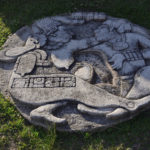

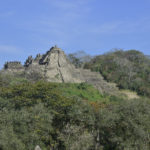



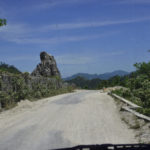





















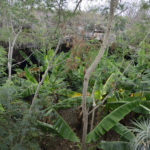

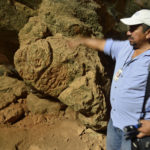

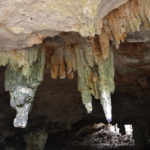












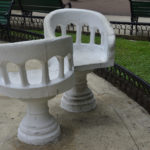




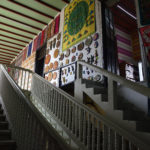
















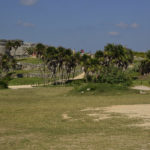








Schreibe den ersten Kommentar